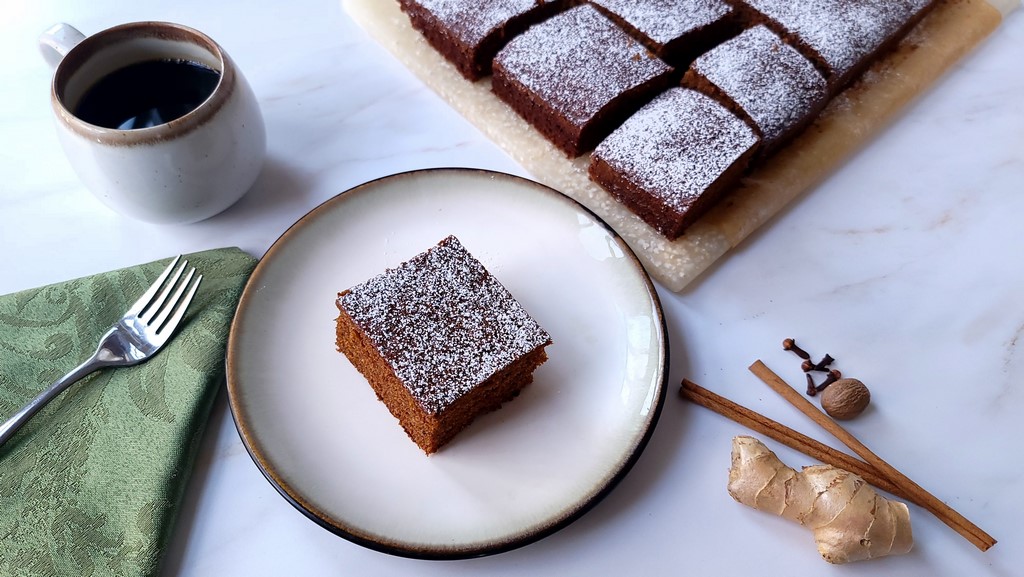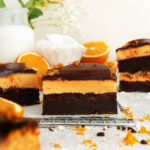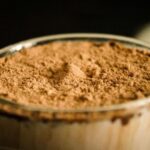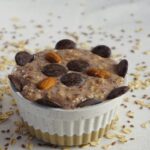This moist and delicious cake is spiced with ginger, cinnamon, cloves, nutmeg and the warm spice flavors of fresh milled rouge de bordeaux wheat flour. It’s perfect for dessert where it can be paired with whipped cream, cream cheese frosting, or even a caramel sauce — or you can enjoy it as a snacking cake with a simple dusting of powdered sugar and a hot cup of tea or coffee. There are a lot of ingredients in the cake, but ultimately it’s quite simple to mix and takes just 30 minutes to bake.
I encourage you to try this cake with rouge de bordeaux flour or red fife flour. Both have distinct baking spice aromas, though this is a bit more intense in rouge de bordeaux. Using any fresh whole wheat flour will work fine and not only increase the cake’s flavor but also its fiber content. The hefty amount of fresh ginger in the batter also adds fiber and flavor. (Using refined all purpose flour or high extraction flour will work too and you don’t need to modify the recipe for these different flours.)
- Dry ingredients
- Creaming the sugar and fats
- Last step, adding beaten egg
The cake is baked in a 9 x 13-inch pan and the batter seems quite shallow when you pour it into the pan, but the cake will expand during baking so don’t worry. Baking powder does plenty of leavening in the cake but overall the crumb is dense in a good way. One interesting aspect of the recipe prep is that you dissolve baking soda in a cup of boiling hot water. This pre-releases the fizz (carbon dioxide), removing some of its leavening power while retaining its relatively high pH. The result is a tempering of the acidity of the molasses, adding some caramel notes, without the crumb blowing up too much.


Gingerbread spice cake is an elegant and satisfying addition to your winter baking repertoire. The warm spices, including fresh ginger, and flavorful wheat options make it a unique and special dessert — or breakfast or snack! Serve with a dusting of powdered sugar or top with whipped cream, cream cheese frosting, or caramel drizzle.
Ingredients
Dry Ingredients (combine in one bowl and set aside)
Wet Ingredients (see instructions, do not combine all at once)
- 1 cup boiling water (237 grams)
- 2 tsp baking soda (11 grams)
- 2 eggs, beaten
- 2/3 cup brown sugar (134 grams)
- 4 Tbsp unsalted butter, room temp (57 grams)
- 3 Tbsp oil (39 grams)
- 2/3 cup molasses (230 grams)
- 1/4 cup honey (85 grams)
- 1 Tbsp fresh ginger, minced (~7 grams)
Topping
- <1 Tbsp powdered sugar for dusting on the cake after it cools
Instructions
- Preheat the oven to 350°F and prep the pan by greasing and dusting it with flour. Option to add a layer of parchment paper that goes up two sides of the pan for easy lifting .
- Whisk the dry ingredients in a bowl — set aside.
- Dissolve the baking soda in a cup of boiling water — set aside.
- Beat the two eggs in a small bowl — set aside.
- In the bowl of a stand mixer using the paddle attachment, cream the brown sugar and butter until lighter in color. Then add the oil, followed by the molasses, honey, and fresh ginger.
- Pour in the baking soda-hot water solution and mix at low speed.
- Add the dry ingredients; all at once is fine but initially mix at low speed to prevent a mess. The batter will seem quite wet.
- Finally add the beaten eggs and mix until they disappear into the batter.
- Pour the batter into the prepared pan and bake for 30-35 minutes or until a toothpick inserted into the center of the cake comes out clean.
- Let the cake cool about 30 minutes then lift it out of the pan. Dust with powdered sugar and cut in squares.
- The cake can be stored at room temperature for several days. To keep it moist, either return any uneaten cake to the baking pan and cover, or keep it on a platter/cutting board and invert the baking pan as a cover.
Notes
The recipe is based off Martha Stewart’s Gingerbread Cake with changes to the flour (from all purpose to whole wheat), the fat (from all butter to butter and oil), and the molasses (less in total and some of it swapped for honey). In cakes, oil tends to make a more tender crumb than butter, whereas butter… has the delicious flavor of butter. For aspects of both and for a slight reduction in saturated fat compared with the original recipe, I used both oil and butter in this recipe. If you prefer all butter, use 8 tablespoons total. For all oil, use 6 tablespoons. The butter-to-oil conversion is 4:3.
The molasses reduction and partial swap-out is simply because I prefer a lighter molasses flavor to allow more of the spice flavors to come through.














